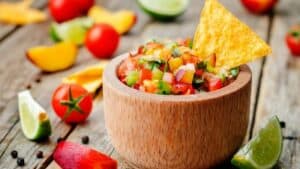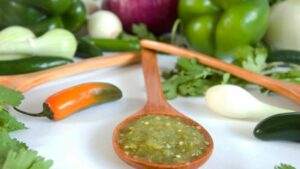Tex-Mex and traditional Mexican cuisines – at first glance they may seem similar, but when you dig deeper there are some key differences between these two flavorful styles of cooking.
In this article, we’ll explore the origins, ingredients, flavor profiles, and iconic dishes of Tex-Mex and Mexican food so you can appreciate the nuances between them. Get ready to learn all about the spicy world of Tex-Mex vs. Mexican cuisine!
The Roots of Tex-Mex and Mexican Cooking
To understand how these cuisines differ, it helps to first look at where they came from.
The Evolution of Tex-Mex
Tex-Mex cuisine originated in the southern United States, mainly in Texas. It blends American and Mexican ingredients and cooking methods, creating a unique fusion style.
Some influences that shaped Tex-Mex food include:
- Native American ingredients like corn and beans
- Spanish explorers introducing dairy products and meats
- Mexican chilies, spices, corn tortillas, rice and more
- German settlers in Texas bringing sausages, dairy foods, and breads
- Southern U.S. barbecuing traditions
With all of these diverse influences coming together, Tex-Mex cuisine evolved over generations into the flavorful style we know today.
The Roots of Mexican Cuisine
Mexican food is deeply rooted in the traditions of the indigenous peoples of Mexico, particularly the Aztec and Mayan cultures. Traditional Mexican cooking reflects influences from:
- Mesoamerican staples like corn, beans, squash, and chilies
- Spanish colonizers introducing dairy, wheat, and meats
- Afro-Caribbean flavors from spices and fruits
- French cooking techniques from the era of French occupation
- Native Mexican culinary creativity and local ingredients
Over centuries, these influences fused together into the varied regional cuisines of Mexico.
How Do the Ingredients Differ?
When it comes to ingredients, there are some key differences between the Tex-Mex and Mexican pantries.
Tex-Mex Ingredients
The Tex-Mex pantry draws heavily from both Mexican and American foods. Some staple ingredients include:
- Beef – Especially ground beef
- Cheese – Cheddar, Monterey Jack, queso fresco
- Onion, garlic, bell peppers
- Beans – Pinto, black beans, refried beans
- Rice – Long grain or Spanish rice
- Corn and flour tortillas
- Tomatoes, lettuce, sour cream
- Chili peppers – Jalapeños, pasilla, ancho
Mexican Ingredients
Authentic Mexican cooking relies on traditional ingredients like:
- Corn – Dried corn for masa and tortillas
- Beans – Black, pinto, kidney, white beans
- Chilies – Ancho, pasilla, guajillo, chipotle
- Tomatillos – Green tomatillo sauce is a key Mexican staple
- Squash – Zucchini, butternut, pumpkin, chayote
- Avocados – Used in guacamole, salads, tacos
- Cheese – Queso fresco, cotija, queso Oaxaca
- Herbs – Cilantro, epazote
- Meat – Chicken, pork, beef, chorizo, shrimp
As you can see, while the cuisines share some key ingredients, they have their differences when it comes to the specifics.
How Do the Flavors Compare?
Beyond ingredients, the use of spices and overall flavor profiles vary between Tex-Mex and traditional Mexican cuisine.
The Bold Tex-Mex Flavor Profile
Tex-Mex cuisine is known for being big and bold when it comes to flavors. Common qualities include:
- Liberal use of spices – Chili powder, cumin, garlic powder, cayenne
- Melted cheese – Queso is a Tex-Mex signature
- Smoky flavors – From grilled meats, peppers, chipotles
- Fried foods – Crispy taco shells, puffy tostadas
- Savory flavor – Added depth from meats, onions, garlic
- Bursts of acidity – Tomatoes, lime juice or vinegar
With all of these strong flavors, Tex-Mex dishes pack a fiery punch on your palate.
The Nuanced Mexican Flavor Profile
In comparison, traditional Mexican cooking focuses on layers of fresh, complex flavors:
- Bright citrus – Lime, lemon, orange juices
- Herby freshness – Cilantro, epazote, mint
- Subtle heat – Guajillo, ancho, chiles de árbol
- Warm spices – Cumin, cinnamon, clove, oregano
- Earthy depth – Chile pasilla, chile negro, huitlacoche
- Savory umami – Roast meats, sautéed veggies
The flavors are nuanced and intended to highlight the essence of the ingredients.
Iconic Dishes from Each Cuisine
To get a real taste for how these cuisines differ, let’s look at some of their most iconic dishes side-by-side.
Quintessential Tex-Mex Dishes
Some all-star Tex-Mex plates include:
- Nachos – Tortilla chips topped with melted cheese, beans, salsa, guac and more
- Tacos – Filled with spicy ground beef, lettuce, tomato, cheese
- Chili con carne – Beef chili made with spices and served over rice
- Fajitas – Grilled skirt steak or chicken with peppers and onions
- Queso dip – Smooth, creamy cheese dip for chips and veggies
- Crispy tacos – Fried corn tortilla shells filled with ground beef, lettuce, and cheese
Classic Mexican Dishes
In comparison, some truly Mexican specialties are:
- Mole – Complex sauce with chilies, spices, chocolate or fruit
- Pozole – Hearty hominy and pork stew
- Tamales – Masa dough stuffed with fillings and steamed in corn husks
- Carnitas – Slow-cooked, tender pulled pork
- Menudo – Spicy tripe soup with hominy and chilies
- Chilaquiles – Day-old tortilla chips sautéed in salsa
- Ceviche – Lime “cooked” raw fish or seafood
- Cochinita pibil – Savory pulled pork marinated in citrus and spices
As shown through the dishes, Mexican cuisine has its own trove of specialties that differ from Tex-Mex favorites.
How To Use Tex-Mex vs. Mexican Ingredients and Flavors
Now that you know more about the ingredients and flavor profiles, how do you incorporate them into your own cooking? Here are some tips:
Cooking Tex-Mex at Home
To recreate Tex-Mex flavors:
- Use chili powder, cumin, oregano in rubs and
spice blends - Make chili con carne with ground beef, beans, and tomatoes
- Top dishes with shredded cheese or creamy queso
- Fry tortillas into crispy taco shells or chips
- Grill meats like skirt steak, chicken, and sausage
- Serve with fresh toppings like lettuce, pico de gallo, guacamole
Cooking Authentic Mexican Food
To capture genuine Mexican cuisine:
- Use dried chilies like ancho, pasilla, and guajillo
- Create complex moles using traditional ingredients
- Make salsas with tomatillos, chilies, onion, cilantro
- Use fresh corn tortillas for tacos and enchiladas
- Slow cook meats like carnitas, barbacoa, or beef cheeks
- Incorporate ingredients like huitlacoche, epazote, and squash blossoms
- Finish dishes with lime juice, queso fresco, and pickled veggies
With these tips, you can start to differentiate your Tex-Mex and Mexican recipes.
Other Mexican Food Styles You Should Know
Tex-Mex and traditional Mexican cuisine aren’t the only Mex-inspired food styles to explore. Here’s a quick look at 3 other exciting regional fusions.
Cal-Mex: California-Mexican Fusion
Cal-Mex combines Mexican flavors with fresh California ingredients and cooking methods. Signatures include:
- Fish tacos with bold rubs and salsas
- Grilled chicken or steak “California-style” tacos with avocado
- Ceviche spotlighting local seafood like shrimp and crab
- Burritos stuffed with grilled meats, guacamole, pico de gallo
- Creative spins like Korean-style tacos with kimchi slaw
Overall, the cuisine highlights the best of SoCal produce and Mexican traditions.
Baja-Mex: Mexican-Coastal Fusion from Baja
Baja-Mex showcases fresh seafood and coastal veggies with Mexican staples. Iconic plates include:
- Grilled fish tacos packed with flavor
- Spicy ceviche tostadas piled with marinated fish
- Paella studded with shrimp, mussels and clams
- Quesadillas filled with sautéed kelp and mushrooms
It celebrates the bounty of both land and sea.
Nuevo Tex-Mex: Modern Twist on Tex-Mex
Nuevo Tex-Mex gives traditional dishes a contemporary makeover. Techniques include:
- Smoking brisket, pork and chicken for incredible depth
- Using exotic produce like finger limes and edible flowers
- Incorporating global flavors like wasabi in salsas
- Employing modernist techniques like sous vide
This innovation puts a creative spin on Tex-Mex classics.
So branch out beyond core Tex-Mex and Mexican food to explore the rich fusions of Cal-Mex, Baja-Mex and Nuevo Tex-Mex! Each offers its own flavor adventure.
Frequently Asked Questions About Tex-Mex vs. Mexican
Still hungry for more info on these tasty cuisines? Here are answers to some common questions:
What’s the difference between Tex-Mex and Mexican salsas?
Tex-Mex salsas often use tomatoes, onion, garlic, canned diced green chilies, cilantro, and vinegar. Mexican salsas feature fresh green and dried red chilies, onion, cilantro, lime, and tomatillos for added tanginess.
Is Tex-Mex considered authentic Mexican food?
No, Tex-Mex is considered a fusion cuisine that combines American and Mexican influences. Authentic Mexican cuisine preserves traditions and ingredients from various regional cooking styles within Mexico.
Which cuisine uses more cheese?
Tex-Mex cuisine is known for incorporating a lot of melted cheese, such as cheddar, Monterey Jack, and queso. Traditional Mexican cuisine uses cheese as well, but favors crumbled queso fresco, cotija, and Oaxaca cheese.
Which has more spice – Tex-Mex or Mexican?
Mexican cuisine has more complex layers of
What’s a good meat for Mexican tacos?
Authentic Mexican tacos often use meats like steak, carnitas, chorizo, barbacoa, tongue, or chicken. Americanized tacos are more likely to contain ground beef.
Explore the Flavor Fusion of Tex-Mex and Mexican Cuisine
Whether you’re in the mood for sizzling fajitas or slow-cooked mole, Tex-Mex and traditional Mexican cuisines offer their own unique flavors.
By understanding the origins, ingredients, dishes, and cooking methods behind each one, you can better appreciate their influences and subtle differences. Tex-Mex may not be truly authentic Mexican, but it still holds a special place in the culinary landscape.
So embrace the spicy joys of Tex-Mex comfort food, then expand your palate with more authentic Mexican cooking. With this guide, you now have the keys to unlocking the delicious secrets of these two incredible cuisines!





